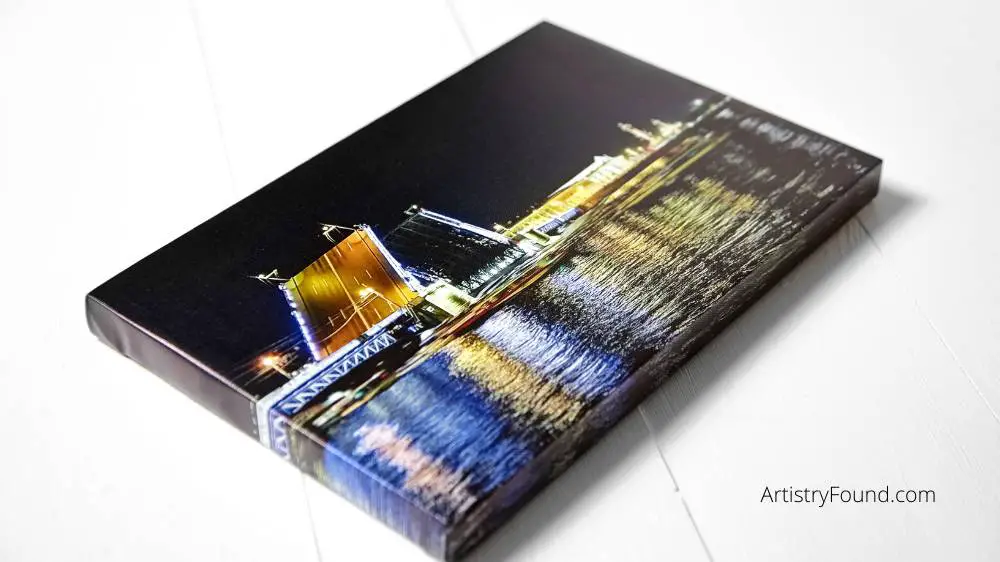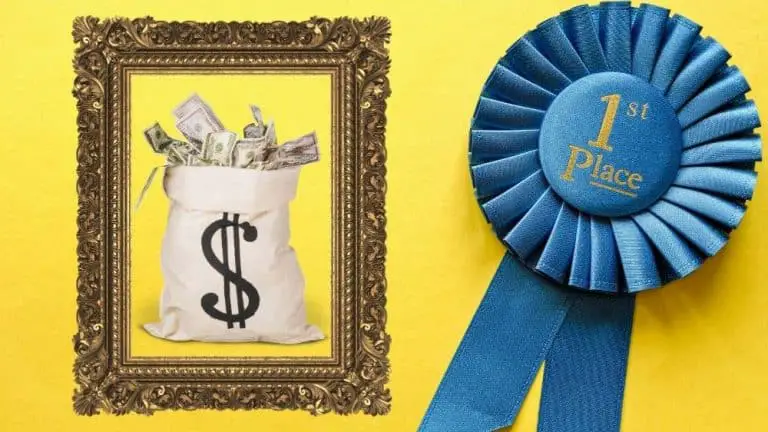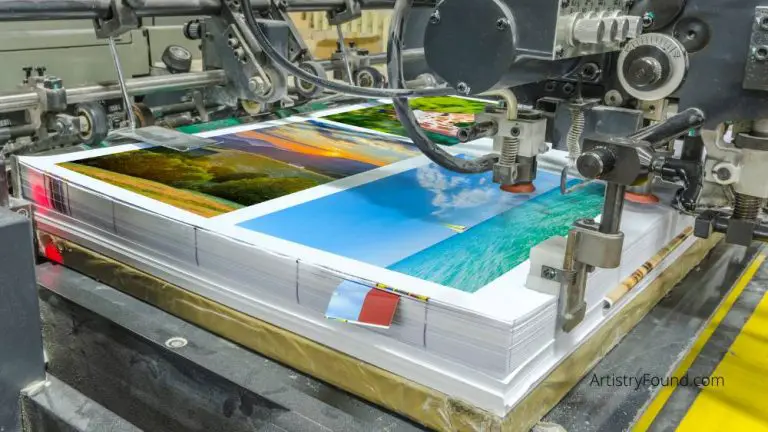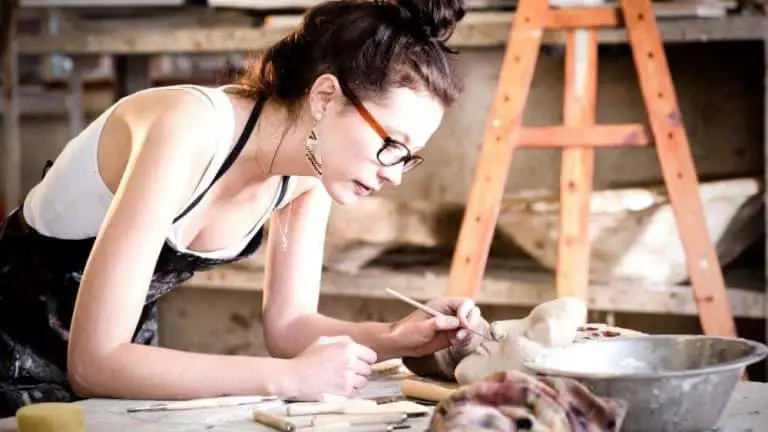How to Correctly Price Art Prints (Easy Guide)
Correct pricing is fundamental to successful art print sales. It allows you to establish and nurture credibility and an excellent reputation among art collectors and buyers. But, how do you correctly price art prints?
The ideal strategy is to choose a pricing formula that works well with your art prints and suits the stage of your career. However, you should also consider the hours spent, cost of materials, the market, your skills and reputation, and what other comparable artists are charging.
This post will show you how to decide what prices to charge for your prints. Of course, what you charge is up to you, but this guide will offer some important things to consider when making this decision.
What is an Art Print?

(This article may contain affiliate links and I may earn a commission if you make a purchase)
Before we take a deep dive into how to price art prints correctly, let’s take a second to talk about what an art print is.
A fine art print is a digital reproduction print produced on paper, canvas, metal, or another surface. In the case of digital photography prints, these would be considered the original artwork, but in the case of an original painting or sculpture, the art prints would be reproductions.
Art prints are printed from a digital file that is created either by taking a digital photograph or creating a scan of the original art piece. This digital file is then used to create as many identical prints as required.
Many painters and other artists sell digital art prints in addition to their original paintings or artwork.
Recommended Reading: Should I Sell My Original Paintings Or Just Prints? (Explained!)
How To Price Art Prints Correctly
Ironically, choosing the selling prices for your fine art prints is more art than science. If you set the price too low you’ll be leaving money on the table, if you set them too high your art prints could start stacking up in the studio.
Hence, you need to find the middle ground. Fortunately, there are a couple of art pricing formulas that painters use to price their original artwork that you can apply to your art prints to give you a good starting point.
Square Inch × Dollar Amount
First, you can price your art prints by multiplying the size of your print in square inches by an appropriate dollar amount. To come up with the square inches, you should multiply the length of the artwork by its width. Then, you’ll want to multiply that number by a dollar figure that seems reasonable based on your reputation and artistic credentials. You can then round that number, up or down, to the nearest hundred (rounded figures are easy for the brain to process).
Emerging artists should consider choosing an affordable dollar amount while established artists can charge higher. You can start with a range of $2-3 per square inch.
If you sell your art prints at galleries, double the cost of your materials as well, and add that value to the square inch price. That will account for the 50% commission galleries often take to sell your piece. But, of course, you don’t have to account for the commission if you’re not selling prints from an art gallery.
Example: For a piece with a length of 20 inches, a width of 16 inches, a square inch dollar amount of $3, and cost of material $75:
(20 inches × 16 inches) = 320 inches
320 inches × $3= $960
Rounded to the nearest hundred = $1000
Double cost of material ($75 × 2 = $150)
Total price ($1000 + $150) = $1,150
(Height + Width) × Multiplier
This is known as linear inch pricing. Simply add the width and length, and multiply by an appropriate dollar amount. This pricing strategy is a good approach, particularly if you have art prints of different sizes. It’s also simpler to explain to potential buyers.
Example: For a 20 × 16-inch painting at $25 per linear inch:
20 + 16= 36 linear inches
36 inches × $25 = $900
Keep in mind the multiplier you use will need to take into account the cost of the print as well as the matting and framing (if any).
Using The Print Pricing Formulas: Reproduction Art Prints vs. Original Art
With the formulas above it’s important to keep in mind that they were developed by painters and artists selling their original artwork. Art prints, on the other hand, are reproductions. Once the digital file is created and edited you’ll be able to print as many as your want.
Therefore you’ll want to take this into account when plugging the numbers into the formulas above. For instance, if you’re creating a limited edition print series (more on that below) the numbers I used in the examples above may not be too far off.
If you’re creating a series of open edition prints, however, you will most likely want to tweak the multiplier number down. The bottom line is that once you’ve used a formula to arrive at a selling price that compensates you fairly for your time and effort, you can use the same formula over and over again for different prints.
Using the formulas also automatically scales the prices for different art print sizes of the same image.
Using the (Height + Width) x Multiplier formula as an example you can sell the same print in multiple sizes and easily come up with a price for each size once you’ve chosen your Multiplier (I used $11 per linear inch in this example).
| Linear Inches (Actual Print Size) | Multiplier | Final Sale Price |
|---|---|---|
| 25 inches (11 x 14) | $11 | $275 |
| 36 inches (16 x 20) | $11 | $396 |
| 50 inches (20 x 30) | $11 | $550 |
This is my favorite way to price art prints because it’s simple to understand and apply. It’s also easy to adjust. For example, if you have an extremely popular print you can simply adjust the multiplier for that print up higher than your normal multiplier.
Also, as your reputation as an artist grows you can increase the multiplier over time. As part of your career plan, you may even want to raise the multiplier by a set amount each year as you become more established.
Some Other Art Print Pricing Strategies

There are a few other print pricing strategies you can use as well.
First, you can make a profit margin by doubling the cost of the art prints and adding 10-20% for the creation of the image. That means even if you sell to a store or gallery, the prices can still be doubled again without making them too pricey.
Another recommendation is to divide the initial set-up costs into the total edition. For example, if you’re planning a final edition of 100, divide your calibration and scanning costs by 100, add that to your per-unit cost, and double the amount to arrive at your selling price.
You should also take advantage of discounts for volume. Your unit per piece costs can be significantly less and the profit margin higher if you have a large order. In other words, base the end price of the print on the full cost to make a single print, then save money by having your prints printed in bulk at a cheaper price.
You can also take advantage of bulk price breaks when selling framed prints as you can often save money when buying these supplies in a larger quanity.
Recommended Reading: Does a Giclee Print Hold Its Value? (Explained)
Things To Consider When Pricing Your Art Prints
When deciding on the best prices for selling art prints it will help if you have a basic understanding of how the art print business works and how an art collector buys and shops for prints.
You should also objectively evaluate the quality and significance of your work in relation to the work available from other artists. That said, let’s break down the basic items you’ll need to consider:
When Pricing Art Prints Consider All The Costs of Running Your Business
Of course, you should make back what you spent in making the art print. However, that should also include your fixed costs such as lighting, heating, office space. The costs can be spread out amongst the number of art prints you plan to sell monthly.
Also, you should consider variable costs, including all of the art supplies you used to create the original work. This might include things like paint, brushes, canvases, cameras, computers, monitors, etc.
The point is that many artists only consider the cost of a single artwork. To be a successful artist and business person, you need to take into account every single one of your expenses when pricing art prints.
Limited Edition Vs. Open Edition Art Prints
When pricing your art print, consider if you’ll be offering limited edition or open edition prints. Limited edition art prints are more valuable and should be priced considerably higher as only a set number of prints will be available for sale.
Conversely, an open edition print doesn’t limit the number of print images offered to the public and thus should be priced less.
The great thing about reproduction art prints, however, is that you can offer both a limited edition series at a higher price point and an open edition of the print at the same time. The limited-edition series of prints, while being signed and numbered, can be printed on a more exclusive surface or use a better quality finish in order to set them apart from the open edition prints.
Use The Prices Of Comparable Art Prints to Price Your Prints
You’ll want to thoroughly research the market you’re competing in to give you a better idea of how to price your art prints. For example, you should consider other art pieces that are comparable to yours in medium, style, size, or color.
It also helps if you look at other artists’ experience, accomplishments, production rate, and geographic location as it compares to you.
Visit galleries, open studios, art fairs, and search online to learn what these artists charge and why. This information will help you to gauge your pricing and make sure it’s in the right ballpark. Moreover, assessing the art world’s accomplishments gives you a sense of how you’re positioned compared to other artists doing similar art prints.
Price Your Art Prints According to Your Skill and Reputation Level
If your art pieces are widely known, the demand for them will be greater. For instance, you could be a rising star whose art has been featured in art magazines, art blogs, and solo exhibitions. Or maybe you’re an established artist with at least 5-7 years of exposure in your market.
The extent to which you’re established will give confidence to buyers to pay higher prices. Conversely, if you’ve not had any solo or media coverage and you’re an emerging artist just starting out, you might have to price your art prints lower, to begin with.
A Signed Vs. Unsigned Print Will Affect The Print Price
Many artists sign their prints at the right bottom corner of the artwork. By signing a print, it’s deemed that the artist is proud of the work and claims it as their own.
A signature counts a lot in the art world as it adds to the piece’s authenticity, especially for known artists. Typically, the value of a signed print is two or more times higher than that of an unsigned one.
The Time and Effort Put Into an Artwork Will Affect The Price of Its Art Print

The amount of time you take to produce an art piece has a bearing on its perceived value. Thus, you should include the time, effort, and thought that has gone into the concept and the process of crafting the artwork. Note that this might be a bit subjective from the buyer’s perspective, and hence you need to be objective and validate the price.
For instance, if you’re a photographer who traveled to Antarctica to capture a stunning image of a baby penguin, you need to take into account your extreme time and effort to capture that image. A print of an image like that will have a much higher perceived value to art collectors than an equally stunning image of a dandelion taken in your backyard.
The same goes for a painting or any other artwork. Art buyers will have a sense of the time and effort you put into creating the art piece and are willing to pay more if the subject matter of the art print was difficult or time-consuming to achieve.
The Market You Are Selling Affects Your Art Print Prices
Determine the market you’re planning to sell your art prints in. Are you selling locally, nationally, or internationally? Set your price accordingly based on the prices of similar prints in the same markets.
For instance, the going price of your print in your city might be slightly higher or lower than the online market price for prints selling internationally.
Understand The Retail and Wholesale Prices of Art Prints
When starting out, you’ll likely sell mainly through your studio. However, even if you sell through a gallery, you might still sell some prints directly to customers.
Selling to customers directly is referred to as retail, and selling through a gallery is considered wholesale.
If selling retail, you can use the tips discussed so far. However, if you’re selling through a gallery, you should consider the commission when pricing the artwork. For instance, if you set your print price at $250 per piece. The gallery will likely take 50% of the sale price. So, your selling price at the gallery should be $500 per piece in order for you to cover your costs and make a profit.
Practicle Tips For Pricing Art Prints
Here are some practical tips for pricing your art prints correctly:
Get Help To Set Your Art Print Prices
Sometimes, professional art evaluators or gallery owners can help you set your price objectively. But ensure the expert doesn’t have a conflict of interest. For instance, you can meet with a professional consultant in your region who’s familiar with your niche.
Take any help you receive in this area as guidance only. Don’t let a gallery or consultant tell you that you need to set your price way lower without a solid reason. As the artist, you should have the final say as to the selling price of your work.
Test Various Print Prices
Pricing artwork is as much of an art as it is a science. Therefore there is no right or wrong way of doing it. So, you can price some pieces at different levels and test which ones sell the most or which ones are more profitable.
Stand By Your Art Print Price
Confidence can do wonders and can help you achieve the price you deserve. So, when you take the time to price your art prints correctly and realistically, you should stand behind your price.
Have confidence in yourself and your prices; otherwise, buyers will figure it out quickly. Moreover, you should ignore any thoughts of lowering the price, and if the buyers want to go below, be ready to justify your price.
Whether you’re okay or not with a bit of negotiation is entirely up to you. Some artists are willing to negotiate, while others are not. Either way is okay but don’t ever go below whatever you set as your baseline price.
Selling works of art at a loss will never be made up for by selling at an increased volume, and a buyer’s promises of greater exposure for your work won’t feed your family.
Keep The Same Art Print Price for Galleries and Your Studio
It’d be best if you didn’t sell your pieces from your studio at lower prices than your work is selling for in a gallery. Galleries put energy and time into sales and aren’t happy to know you’ve been selling work for less and will stop showcasing your pieces. Moreover, other galleries might learn about it and become less inclined to work with you.
So, ensure that you set similar prices for your work whether it is in a gallery or your own studio to maintain a positive relationship with the galleries. Your art prices should also remain consistent, whether the works are offered offline or online.
Recommended Reading: Giclée vs Screen Print: What is the Difference?
Common Mistakes to Avoid When Pricing Art Prints

Collectors and buyers who view art prints more objectively don’t understand certain value judgments and may view your pricing strategy as inconsistent or confusing. Nobody likes buying anything they don’t understand. Hence, avoiding different mistakes that artists make when pricing their artwork is crucial.
Here are some of the common mistakes that artists make when pricing prints that confuse art buyers:
Setting The Art Print Price Emotionally
It’s easy to be attached to an art piece in which you’ve invested your time, effort, and emotion. However, while being proud of your creativity is excellent, letting emotions influence your pricing is not.
For instance, an artist may place special meanings on such pieces and consequently place excessively high prices. Moreover, an artist can place low prices on artwork that they consider lacking in some regard or don’t have a personal attachment to.
Therefore, pricing should be predominantly based on physical attributes and not personal value. That’s because it’s hard to explain subjective qualities such as emotional attachment to buyers. Keep the art off the market if you feel exceptionally close to it, and save it for your private collection to avoid this pitfall.
Ignoring The Bigger Art Market Picture
Some artists tend to focus only on their art and don’t pay much attention to the rest (some even dismiss the other art as irrelevant). In such cases, your prices may make perfect sense to you but little sense within the broader context of the art world.
For instance, if several artists are selling 16 x 20 prints of a bouquet of flowers in a vase for $325 and you’re selling your similar print for $600, you probably won’t be selling a lot, if any, of that print.
Note that the more aware you’re of the bigger picture, the more you’ll correctly price and market your pieces. You’ll also understand who’s buying what, why, and for how much.
Underselling Yourself by Pricing Your Art Prints Too Low
Lots of artists sometimes get the feeling that they don’t belong. That’s known as the impostor syndrome, which makes you feel like you shouldn’t be charging what comparable artists are charging. But creating an art print can be time-consuming and require costly materials.
Therefore, you should consider costs of materials and a reasonable hourly wage- The US Dept. of Labor indicates the average hourly wage for a fine artist is $24.58 (you can use that to estimate). In fact, if the price doesn’t make you feel a little uncomfortable (like you’re charging too much), then you’re probably undercharging.
When is The Ideal Time to Raise Art Print Prices?
You can raise the prices of your art prints when you’re experiencing a consistent degree of success and have established a proven record of sales lasting at least six months. You should be selling at least half of all the art prints you produce within a reasonable period, say six months or less.
Consequently, as the sales continue to rise and demand is high, you can increase the prices at least 10-25% after a year or two. Note that, like other price-setting strategies, you should be able to justify the increases with facts.
Should You Lower Prices If Your Art Prints Aren’t Selling?
Don’t be too hasty to lower the prices of your art prints. That’s because if a buyer sees the prices of the art prints going down, they might be less likely to buy them.
So instead, ensure that you or your gallery are putting effort into promoting the pieces before blaming the prices.
First, however, check out comparable artists (same size, medium, and place in career) for an idea of where to price. Typically, your prices should only go up over time.
Final Thoughts on Pricing Art Prints
While pricing reproduction art prints isn’t an exact science, using the ideas, formulas, and tips in this article should give you some great ideas of where to begin.
The main point is to have confidence in your work and the prices you’ve set as that belief will transfer over to your buyers. Also, remember to take ALL of your expenses into consideration when pricing your art prints.
That way your buyers will be getting a great print at a price that offers you a proper return for your investment in terms of time, energy, supplies, costs, and emotion.
More From Artistry Found
- Art Print vs. Poster Print (What’s the Difference?)
- Making Beautiful Art Prints at Home (Step-by-Step)
- 4 Creative Ways To Thank Someone for Buying Your Art!
- The Complete Guide to Making Your Art More Sellable (Attn: Artists)
Sources:






